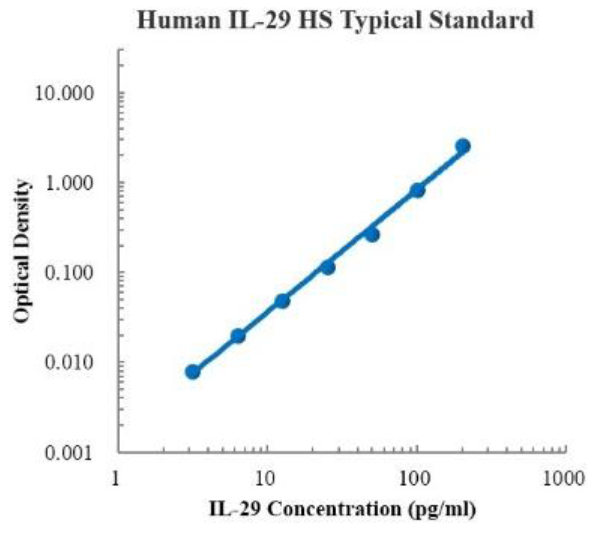| Description | Detection Principle: This kit uses double antibody sandwich ELISA technology. The specific anti-human IL-29 capture antibody was pre coated on a high affinity microplate. Add the standard, the sample to be tested and the biotin labeled detection antibody into the wells of the enzyme plate in turn, shake well and mix well, and then place it at room temperature for 2 hours of incubation process. The IL-29 present in the sample combines with the solid-phase antibody and the detection antibody. After washing sufficiently to remove free and unbound components, streptavidin HRP (sa-hrp) labeled with horseradish peroxidase was added. After washing, signal enhancer was added for incubation. After washing to remove unbound material, sa-hrp was added again. After washing again, TMB chromogenic substrate was added and incubated at room temperature in the dark to develop color. The depth of color response is positively correlated with the concentration of IL-29 in the sample. Add stop solution to stop the reaction, and use a microplate reader to measure the absorbance value at 450 nm detection wavelength (correction wavelength 570-630 nm).
Detection Type: Double antibody sandwich method Form: Pre coated 96 well plate Test Sample Type: cell supernatant, serum, plasma Loading Amount: 100 μ L Kit Components: A copy of pre coated 96 well plate, standard, IL-29 detection antibody, standard dilution, detection buffer, signal enhancer, signal enhancer dilution, TMB chromogenic substrate, washing solution, termination solution, sa-hrp, plate sealing membrane and instructions. Sensitivity: 0.08pg/ml Detection Range: 3.13-200 pg/ml Recovery Range: 86-108% Storage Method: 2-8 ℃ Standard Curve: 
Background: Interleukin 29 (IL-29), also known as interferon λ 1 (ifn-λ 1), a member of the helical cytokine family, is a type III interferon. Its amino acid sequence is highly similar to that of Il-28, another type III interferon. The IL-29 gene is found on human chromosome 19, but it does not exist in the mouse genome. IL-29 plays an important role in host defense against microorganisms, and its gene is highly upregulated in virus-infected cells. IL-29 has significant antiviral activity and immunomodulatory properties, which can be similar to ifn-&alpha through induction/Β Activated cellular antiviral response to inhibit virus replication. However, IL-29 is bound to a unique receptor, so in the process of natural infection, this cytokine may interact with ifn-&alpha/Β Or ifn-γ It may also work together with other cytokines to treat chronic viral infections such as hepatitis C (HCV). The antiviral activity of IL-29 includes the upregulation of class I MHC expression on the cell surface and the upregulation of PKR expression. The ligand / receptor complex appears to signal through the JAK STAT pathway. |





